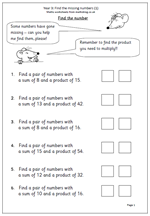 What looks like a very simple worksheet is actually rather tricky. There are six statements about pairs of numbers, along the lines of:
What looks like a very simple worksheet is actually rather tricky. There are six statements about pairs of numbers, along the lines of:
Find a pair of numbers with a sum of 8 and a product of 15.
Firstly, children need to know that the sum of two numbers is found by adding up. Secondly, they need to know that to find the product of two numbers they need to multiply them together.
It is then a matter of some ‘trial and error’ work, finding two numbers which meet one of the criteria and then seeing if they meet the other. For those who are good at times tables it is more efficient to start with finding products, as there are less possible answers.







